Emoji Language: Can You Really Communicate Without Words?


Emojis have evolved into emotional tone-setters in digital conversation. But can they really replace language? We break down how far emoji communication has come—and where it might be heading.
So. Can we actually talk using just emojis?
I mean — not like completely replace language or anything, but... still. It feels like we've gotten kind of close, right?
Sometimes I send someone a 🙃 Upside-Down Face→ and that's the entire message. No words. Just the face. And somehow they know what I mean. Or at least they reply like they do, which is probably close enough.
Not Exactly a Language, But...
Emojis don't really follow the rules of language:
- No formal grammar
- No fixed meanings
- No structure
One emoji can mean ten different things. Or nothing.
It depends on the person, the mood, the moment.
Take 😭 Loudly Crying Face→ for example:
- Technically crying
- But now used when something's hilarious
- Or when overwhelmed
- Or just to exaggerate for effect
This didn't come from an official source.
It just happened. We all kind of agreed on it over time.
If you're curious about how emoji meanings evolve and change across cultures, check out our complete guide to emoji meanings for a deeper dive into the complexity behind these tiny symbols.
You Can Chat in Emojis. Kinda.
I've tried it. Only using emojis to reply for a while — like a mini experiment.
At first, it worked:
- A few 🍕 Pizza→💬 Speech Balloon→👀 Eyes→
- The other person got the idea
But it falls apart quickly.
You hit a thought you can't express in tiny pictures. And then comes the moment:
"lol wait what I mean is—"
And just like that, you're back to typing.
So yes — you can communicate with emojis...
But not all the way.
Want to test your emoji communication skills? Try our Emoji Guessing Game to see how well you can interpret emoji sequences without words.
Emojis Fill the Gaps
This is where emojis really shine:
Filling in tone that's missing from plain text.
- A message that feels flat or cold
- Add a 😊 Smiling Face With Smiling Eyes→ or 😅 Grinning Face With Sweat→
- Suddenly it feels softer, more human
They're like facial expressions for typing.
And in that way, they're extremely effective.
For more on how emojis evolved from simple expressions to complex communication tools, explore our evolution of emojis guide that traces their journey from basic icons to AI-powered communication.
The Catch: They're Vague
But here's the issue: they're also vague.
- You think you're being lighthearted
- They think you're being passive-aggressive
- Or worse — they have no clue what you meant
And honestly? That's fair.
There's no manual.
We're all just reading vibes and hoping for the best.
This ambiguity is exactly why some of the most popular emojis are also the most misunderstood. The same emoji can mean completely different things depending on who's using it and in what context.
So — Can You Really Communicate Without Words?
Sort of.
If:
- The context is simple
- The person knows you well
- The message is emotionally clear
Then yes — emojis can carry a lot.
But for:
- Complex thoughts
- Emotional nuance
- Specific ideas
You'll still need words.
Curious about which emojis are most effective for different types of communication? Our top 100 most popular emojis→ analysis reveals which ones people use most and why they work so well.
Final Thoughts
Emojis aren't replacing language — but they're changing how we use it.
They make our messages:
- Friendlier
- More expressive
- A little less robotic
Even when they don't quite land, they bring personality to digital conversations.
And in a world full of short texts and fast replies, that counts for a lot.
Want to explore more about emoji communication? Check out our Text to Emoji tool to see how AI interprets your words into emoji expressions, or try our What Emoji Are You quiz to discover which emoji best represents your personality.
Share this article
Help others discover this content
Related Articles

What Do Emojis Mean? A Complete Guide to Emoji Meanings
You sent 😊 thinking it was friendly, but got no reply — did you just send the wrong message? Emoji meanings can be surprisingly complex. In this guide, we explore what emojis really mean and how context, platforms, and culture shape them.


How to Copy and Paste Emojis on Any Device
Using emojis on your computer shouldn't be this complicated. Here's the easiest way to find, copy, and paste emojis—on any device, anytime, totally free (and yes, you're already on the right site).


The Evolution of Emojis: From Smiley Faces to AI Integration
Emojis started as pixelated icons from 1990s Japan, and now they're part of AI-powered communication. This deep dive explores how emojis evolved from basic expressions to smart, emotional cues influenced by artificial intelligence.

